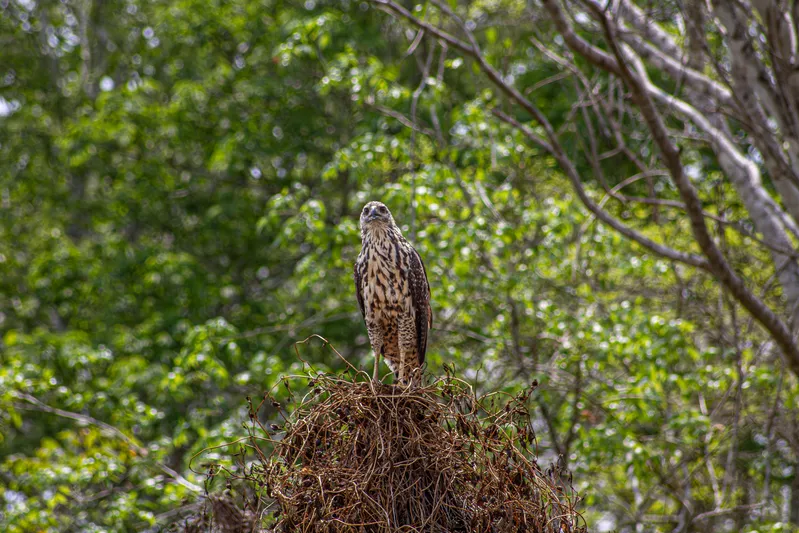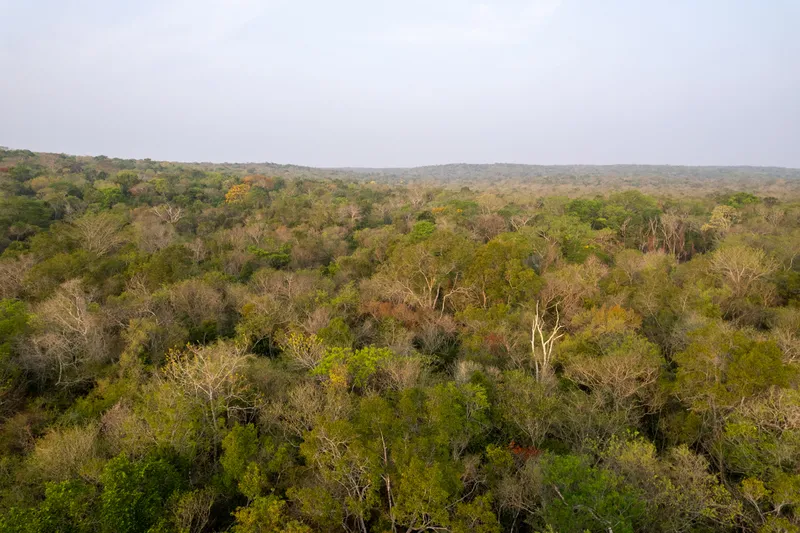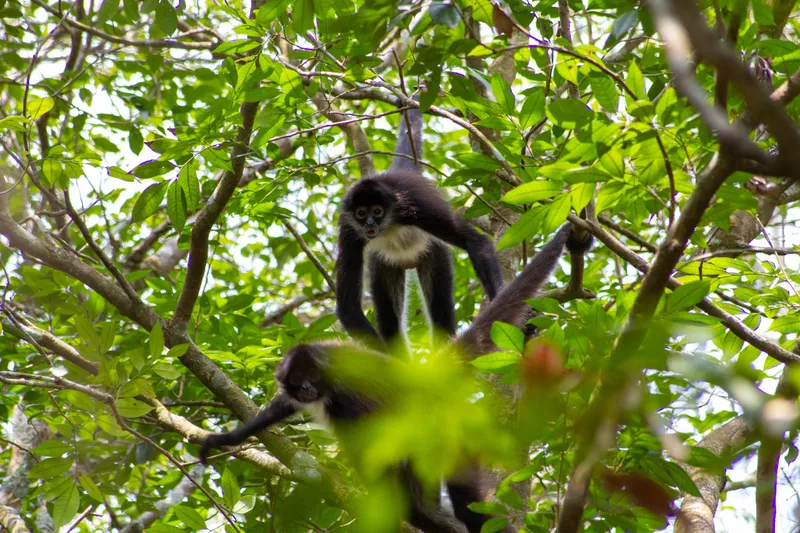Conversations with Southeastern Mexico



Yes, Mexico is a megadiverse country, we already know this very well; some of us even laugh internally every time a thesis, article or presentation introduces the number of organisms that inhabit our country in this way. We laugh because of the daily nature of the phrase, not because of denying its indisputable truth. We have almost all the climates described, with the exception of polar and upland climates; our vegetation ranges from xerophilous scrub and grassland to tropical rainforests (Challenger, 1998); we are the third country with the highest diversity of mammals in the world; we have almost 70% of the world's species diversity (Mittermeier et al., 2004). And so we could go on.
But what exactly is diversity? Biodiversity is known as the variety of life. The concept includes several levels of organization and encompasses the differential number of species of plants, animals, fungi and microorganisms that live in a given space, their genetic variability, the ecosystems of which they are part and the landscapes or regions in which these ecosystems are located. It also includes ecological and evolutionary processes. A megadiverse country is one that concentrates more than 70% of the organisms that inhabit the planet in its territory (Mittermeier and Robles, 1997).
So how is it possible that in this paradise of diversity that is the place where we live, such accelerated processes as the extinction or imminent threat of a species are happening? Mexico is a megadiverse country with many environmental problems.
In our years as biologists, what we have read and seen about the country's natural wealth is how it deteriorates and as increasingly, the human pressure we exert on it results in the destruction of entire ecosystems and the extinction and threat of species of all types. Because of the above context, today we decided to talk about one of the areas of Mexico where a large amount of biological diversity is found: the Mexican southeast and focusing specifically on a part of the diversity that generates a lot of admiration for us: fauna. We chose this region because it is also an area of Mexico where life is in danger, and a lot. Today we decided not only to talk as authors and biologists, but to talk with the most relevant and indispensable actors for the protection of our country: those who live and work with nature.
We spoke with Don Emiliano Torres Cruz, ejidatario de Conhuás, where, hand in hand with the people who own the land, we developed a project which seeks to protect the jungle and generate carbon credits, for their benefit and for the planet.
Toronto: Don Emiliano, tell us: do you feel that the fauna has remained the same since you arrived at the ejido?
Don Emiliano: Of course not. Formerly it was - well, twenty-five years ago - it was something beautiful because you only walked two or three kilometers and saw different fauna. Turkeys, pheasants, deer. There is one that we call “sereque” and well, not so much lately, maybe there has been a radical [negative] change here for ten years. I think that in the agricultural area there is quite a decrease: you can no longer see the fauna so much.

The infinite jungle of Ejido Conhuás
Southeastern Mexico is the largest forested area in the country and is particularly important in terms of species richness (number of different species in a community), since this is where two of the main biogeographic regions (areas with patterns of distribution and evolution of specific species) of the planet, the nearctic and the neotropics, intersect, so Do species typical of North America coexist with species characteristic of southern America. This peculiarity is largely responsible for the biodiversity that inhabits the Southeast (Benítez and Bellot, 2007).
Specifically, the state of Campeche has 3.95 million hectares (ha) of rainforest, more than 70% of the state's coverage and is the one with the largest mangrove area, 30% of the national total (SDS, 2018). These jungles and mangroves are home to a large amount of wildlife. However, despite efforts to conserve part of the biological resources that keep these jungles alive, the problem of deforestation it has worsened in the state year after year, being one of the main causes of the extinction of priority species, given that as forest cover decreases and productive activities increase in newly deforested areas (such as livestock activities or the planting of monocultures), animals lose the habitat that allows them to acquire the basic needs to survive, such as food and housing.
A similar case occurs in Quintana Roo, whose vegetation cover is more than 75% of the state's total, with the jungle being the most representative type of vegetation and the most inhabited by local fauna. In Chiapas, another state where tall and evergreen forests predominate, as well as pine and oak forests in higher altitude regions, fauna is also a very abundant resource, but also a very threatened resource (March et al. , 2008).
Toronto: How important do you think animals are to the jungle?
FROM: Uuuyyy, a lot. More than anything for... How will I tell him? Both bees and animals play a very important role for the jungle, because I think that the vegetation that we think is useless, is a source of food for the animals. If we all thought the same way, in this direction, I think that fauna is something important, because if there were no fauna in the jungle, I think we wouldn't have life, more than anything. We wouldn't have a life.
We agree with Don Emiliano: if there were no fauna in the jungle, we wouldn't have life. Ecosystem dynamics are very complex networks of interactions, which of course have a sociocultural component when human communities are present and interact with nature. Part of the megadiversity that exists in Mexico is due to the interaction we exert on it. It is no coincidence that 66 indigenous languages are spoken in our country and nine of the twelve countries with the greatest linguistic richness are also considered megadiverse (Toledo et al., 2001). Life is woven in complex ways, but without hesitation, without the domestication and management of the natural resources that surround us - be they flora or fauna - today our civilization would not be in the position it has.
However, not all human interactions with nature are beneficial, as is clear to us. Another serious problem that threatens wildlife in the jungles of the southeast is poaching. This activity occurs because there is an illegal market for species that sells hides and other physical derivatives of animals. The jaguar and the tapir are species that are extremely endangered due to this problem, and they are also priority species for conservation, since around them there are a large number of ecological relationships that allow the correct balance and dynamics of the surrounding communities, in addition to having -again- a cultural importance which often places these animals at the center of local worldviews and ideologies. Another major threat to wildlife in the Southeast is the illegal exploitation, which includes activities such as the capture, transportation and unauthorized trade of wildlife. For greater protection, there is NOM-059-SEMARNAT-2010, which is the Mexican standard that lists endangered species, and is operated by PROFEPA (Federal Attorney for Environmental Protection).

Spider monkey (Ateles geoffroyi) seen in the Conhuás ejido
Toronto: Do you think that with this joint project that we have [nature conservation and forest carbon sequestration] there will be more protection for fauna?
FROM: Personally, I feel that way. Yes, it's going to be quite important because people are becoming aware of caring and not going hunting, not only in [the area of projects] carbon credits, [but] taking care of wildlife in general. I think this project will be very useful for everyone.
Wildlife protection goes beyond monitoring, management and conservation programs -although we consider them paramount-; what we mean by this is that protection is something that comes from empathy and early awareness of the benefits and services that fauna provides us, so environmental education is an equally relevant task, but quite forgotten: environmental education without hesitation begins at home -as Don Emiliano will mention later-, but it cannot be fully consolidated without the support of public policies and institutions that promote it, in such a way that the link with government sectors is essential to achieve common conservation objectives (Benítez and Bellot, 2007).
Toronto: Do you consider that wildlife protection work brings some benefit to children and young people in the region?
FROM: I think so, because from home we have to implement that culture to the boys, to care more than anything right now, with the climate change that we have. In fact, what I'm doing now is reforest. To reforest with plants that we say we have: berry, ramón, oak that we say have abundant foliage. And we tell them! That if we finish what is the jungle, the day will also come when we will not endure the heat. I feel that this is a culture that we must implement in them and they will understand and value it. For me that is very important.
Due to all of the above, the carbon credit projects that are being implemented in the states of Campeche -where the ejido of which Don Emiliano is part is located-, Quintana Roo and Chiapas, they seek to promote the restoration of the jungle, which leads to its imminent conservation, generating several benefits: on the one hand, provides an annual income to ejidatarios who own the land for their essential work to sustainably manage their resources, and on the other hand, allows them to have a cultural reappropriation of the ecosystem, which promotes, yes or yes, awareness of the above-mentioned problems.
In conclusion, we would like to close with what we consider to be a commonly mentioned error when we talk about the importance of conserving and restoring resources: as we well know, the growth of the human population has been accelerating, causing severe changes in the dynamics and ecological processes of the world's tropical forests/jungles. However, It would be hypocritical to say that population growth is the cause of the environmental debacle: the increase in programs focused on developing agricultural, livestock and logging activities -where sustainable resource management is not carried out- has caused a rapid change in land use, transforming tropical forests into an irregular matrix, where human activities dominate the new landscape, affecting regional biodiversity (SDS, 2018). In other words, population growth would not be such a significant problem, if the natural resources on which these people depend were distributed in more equitable and sustainably managed ways, so in our opinion, the most relevant action to take into account to improve the health of the socio-ecosystem is to restore. Restore the jungle, fauna and social fabric.
The Territorial Management and Management plans that we have implemented in Toroto and that will continue in the Calakmul area as part of our carbon dioxide projects include mandatory activities such as biodiversity monitoring, which makes it possible to combat poaching and illegal exploitation; the biodiversity management, which makes it possible not to overexploit resources with material benefits from them; the jungle management, which involves the sale of carbon credits and thus an economic gain for land owners that allows them to live on conservation, rather than degradation; and the creation of biological corridors, which promotes that species with a wide distribution ensure their livelihood over the years. All of these activities are for restoration, and go beyond merely stating the exacerbated growth of the population.
The population is growing, yes. But who cares for the resources that life depends on?
For this reason, we wanted to talk to Don Emiliano, to know his perspective on the main problems surrounding wildlife, to know what actions he is taking to protect them, and very importantly, what he sees in his future:
Toronto: Don Emiliano, how do you imagine the future of wildlife?
FROM: We hope that this will return to normal [when you went out for a walk for two or three km and could observe fauna in its natural environment]. We are aware of this project that we have [with Toroto]. We think that this will influence the conservation of wildlife, because we no longer deforest, we believe that we are going to see a radical change in the ecosystem. Let's hope that maybe in two years we'll see a change, quite, quite well.
We want to imagine a future of radical change as well. A future where ecosystems thrive, where societies learn to manage ourselves sustainably and to nourish ourselves from them, as they do from us; to relate respectfully, then. We want to imagine a future where fauna does not suffer from habitat displacement, from clearing, from fires caused by mismanagement or climate change; a future where the need for poaching no longer exists, where environmental education teaches us that exploitation must be fair and sustainable, where Don Emiliano sees again -just two or three kilometers from his town- turkeys, pheasants, deer and sereques.

Sunset in Ejido Conhuás
References
Explore reflections, research and field learning from our work in ecosystem restoration.